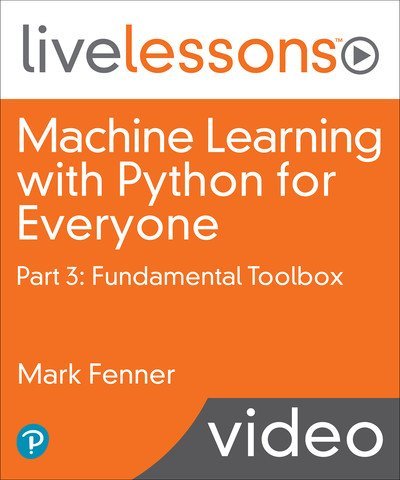
Linkedin Learning
Duration: 4h 36m | Video: 1280×720 30fps | Audio: AAC, 48 kHz, 2ch | Size: 1.21 GB
Genre: eLearning | Language: English
Code-along sessions move you through the development of classification and regression methods
Overview
Machine learning is moving from futuristic AI projects to data analysis on your desk. You need to go beyond following along in discussions to coding machine learning tasks. Machine Learning with Python for Everyone Part 3: Fundamental Toolbox shows you how to turn introductory machine learning concepts into concrete code using Python, scikit-learn, and friends.
You will learn about fundamental classification and regression metrics like decision tree classifiers and regressors, support vector classifiers and regression, logistic regression, penalized regression, and discriminant analysis. You will see techniques for feature engineering, including scaling, discretization, and interactions. You will learn how to implement pipelines for more complex processing and nested cross-validation for tuning hyperparameters.
About the Instructor
Mark Fenner, PhD, has been teaching computing and mathematics to diverse adult audiences since 1999. His research projects have addressed design, implementation, and performance of machine learning and numerical algorithms, learning systems for security analysis of software repositories and intrusion detection, probabilistic models of protein function, and analysis and visualization of ecological and microscopy data. Mark continues to work across the data science spectrum from C, Fortran, and Python implementation to statistical analysis and visualization. He has delivered training and developed curriculum for Fortune 50 companies, boutique consultancies, and national-level research laboratories. Mark holds a PhD in Computer Science and owns Fenner Training and Consulting, LLC.
Skill Level
Beginner to Intermediate
Learn How To
Use fundamental classification methods including decision trees, support vector classifiers, logistic regression, and discriminant analysis
Recognize bias and variability in classifiers
Compare classifiers
Use fundamental regression methods including penalized regression and regression trees
Recognize bias and variability in regressors
Manually engineer features through feature scaling, discretization, categorical coding, analysis of interactions, and target manipulations
Tune hyperparameters
Use nested cross-validation
Develop pipelines
Who Should Take This Course
This course is a good fit for anyone who needs to improve their fundamental understanding of machine learning concepts and become familiar with basic machine learning code. You might be a newer data scientist, a data analyst transitioning to the use of machine learning models, a research and development scientist looking to add machine learning techniques to your classical statistical training, or a manager adding data science/machine learning capabilities to your team.
Course Requirements
Students should have a basic understanding of programming in Python (variables, basic control flow, simple scripts). They should also have basic familiarity with the vocabulary of machine learning (dataset, training set, test set, model). They should have a working Python installation that allows them to use scikit-learn, pandas, matplotlib, and seaborn.
Lesson Descriptions
Lesson 1: Fundamental Classification Methods I
In Lesson 1, Mark dives into two important classification methods: decision trees and support vector machines. Decision trees capture the idea of using if-then rules to put examples into buckets. Support vector machines are based on some pretty heavy mathematics, but Mark addresses them from a very graphical point of view.
Lesson 2: Fundamental Classification Methods II
In Lesson 2, Mark continues to add to your classification toolbox. He discusses two methods: logistic regression and discriminant analysis. These methods can classify examples and they can also give us an idea of the certainty of that classification. Mark also compares many classification techniques.
Lesson 3: Fundamental Regression Methods
In Lesson 3, Mark turns his attention toward regression models, also called regressors. He considers modifications of linear regression called penalized regression and a variation of decision trees called decision tree regressors. Decision tree regressors build on the idea of if-then rules but are adapted to numerical outcomes. He also compares many regression techniques.
Lesson 4: Manual Feature Engineering
In Lesson 4, Mark looks at the various ways we can manually modify our learning data. He discusses ways to rewrite features by adjusting their numerical scale, by converting them from numeric to categorical values, or by manipulating the way we encode categories. He also talks about adding new features: feature construction. Finally, Mark covers ways to modify the target to support learning.
Lesson 5: Hyperparameters and Pipelines
In Lesson 5, Mark addresses fine-tuning your models by selecting good hyperparameters and creating longer processing chains with pipelines. Hyperparameters control the inner workings of our models: two models that differ only in their hyperparameters may give very different results. Creating pipelines enables us to couple feature engineering, model selection, and model building into one streamlined object.
Password/解压密码www.tbtos.com
转载请注明:0daytown » Machine Learning with Python for Everyone, Part 3: Fundamental Toolbox